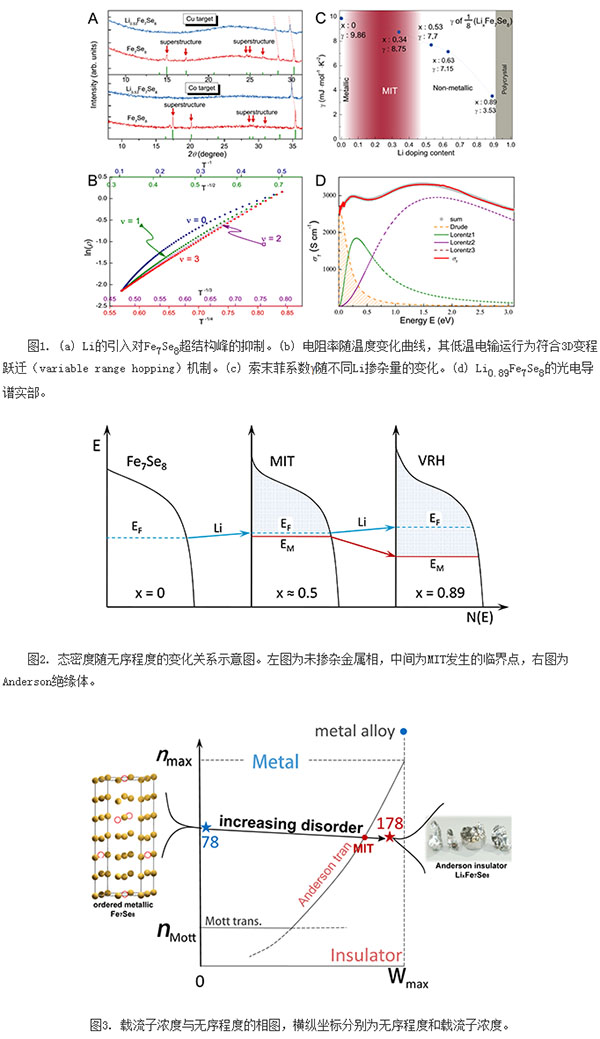More than half a century ago, PW Anderson proposed that disorder could induce the localization of electrons and spins. Anderson localization has extensive and profound influence on several concepts and phenomena in the field of physics, such as quantum Hall effect, quantum critical point, random matrix theory, and electron interaction in disordered metals. Although originally proposed for electrons, Anderson localization is essentially a local phenomenon of waves, and is first implemented in systems such as photons, phonons, cold atoms, mechanical waves, material waves, and low-dimensional electrons. For the three-dimensional electronic system, a lot of early work focused on the metal-insulator (MIT) transition in heavily doped semiconductors, but its MIT transition is mainly related to the transition of the discrete energy level of impurities to the energy band, that is, degenerate semiconductors, not research. Anderson's ideal system of localization. Recently, the M. Wuttig group in Germany discovered for the first time in the GeSb2Te4 polycrystal that the MIT transition was caused only by disorder, and its electron localization originated from the disordered distribution of the vacancies in the Ge/Sb sublattice. However, due to its small grain size (10~20 nm), it is inconvenient to further study the influence of lattice disorder on localization of electrons. In order to study the influence of disorder on the electronic system, it is an important research topic to implement Anderson localization of the electronic system in three-dimensional single crystals. Recently, Institute of Physics, Chinese Academy of Sciences/Beijing Advanced Laboratory for Advanced Materials and Structure Analysis of Condensed Matter Physics National Laboratory (Group A02) Dr. Ying Tianping, Group T03, Dr. Gu Yueqiang (Teacher Dai Xi), Researcher Chen Xiaolong, Associate Researcher Jin Shifeng Zhang Wei, a researcher at Xi'an Jiaotong University, succeeded in obtaining the centimetre-level monocrystalline LixFe7Se8 by electronically doping the Fe7Se8 metal matrix and simultaneously inducing the disordered occupation of iron in the system. Anderson's local electrons were observed. Phenomenon. First, the superstructure peak of the parent disappeared after powder incorporation after Li incorporation, and the structure was restored to a simple NiAs structure, indicating that Li doping into the Fe site and disrupting the ordering of the Fe atom (Fig. 1a). This phenomenon is further promoted. X-ray single crystal diffraction, TEM and magnetic measurements confirmed. Second, as the degree of disorder increases, the MIT transition occurs in the LixFe7Se8 system and exhibits a three-dimensional transition transition at low temperature electrical transport, indicating the presence of localized electrons on the Fermi surface (Figure 1b). It is necessary to point out that no change from T-1/4 to T-1/2 is observed in the resistivity curve up to 2K, ie no Efros-Shklovskii gap opening is observed. Again, the most significant difference between Anderson insulators and other insulators is the presence of a large number of localized electrons at the Fermi surface. Specific heat and infrared spectroscopy data confirm that there is a large density of states in the LixFe7Se8 insulating sample (Fig. 1c, d). Finally, quantitative analysis of carrier concentration, mobility, and preliminary DOS calculations both support the presence of LixFe7Se8 as Anderson insulator, and near the MIT transition point, the relationship between carrier concentration and localized length deviates significantly from the Mott criterion. The above phenomenon can be explained by the evolution of DOS with different levels of disorder (Figure 2). The incorporation of Li in Fe7Se8 has two roles: electron doping and introduction of Fe/Li/vacancy site disorder. The electron doping will slightly raise the Fermi surface; the disorder produces a local state at the tail and forms a mobility edge. When the mobility crossed the Fermi surface, the MIT transition occurred. Figure 3 shows a more universal map of carrier concentration and disorder, helping people discover more Anderson insulators. This figure shows that moderate carrier concentration and high degree of disorder easily induce Anderson insulators. This is the first time that the electronic system Anderson has been localized in large single crystals. This study provides a new research platform for research on disorder and MIT transformation research. The study of this system will deepen people's interest in disordered materials. Knowledge of electronic behavior. The results of related studies were published in the recent Science Advances [Anderson localization of electrons in single crystals: LixFe7Se8.Sci.Adv. 2, e1501283 (2016)]. The above research work has been funded by the National Natural Science Foundation of China (51532010, 51472266, 91422303, 51202286), the Ministry of Science and Technology, the Chinese Academy of Sciences Pilot Project B (XDB07020100) and ICDD. Oil Drilling Machinery, Oil Drilling Hydraulic Elevator, Oil Drilling Tools, Oil Equipment Rugao Yaou Import & Export Trade Co., Ltd , https://www.ntyaoumachinery.com